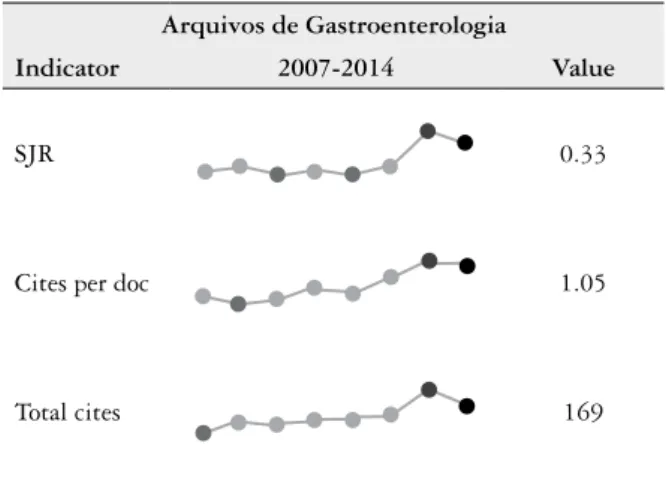ARQGA/1802
EDITORIAL
v. 52 no. 4 - out./dez. 2015 Arq Gastroenterol 253
DOI: 10.1590/S0004-28032015000400001
* Editor Chefe da Arquivos de Gastroenterologia
ONE DAY AT A TIME…
Viebig RG. One day at a time... Arq Gastroenterol. 2015;52(4):XXX
The guidelines of the Archives of Gastroenterology
follow the ideals of its founder, Prof. José Fernandes Pontes. The principles of neutrality, independence and editorial freedom continue.
However, to develop and grow within the publish-ing world it is necessary to be aware of the changes and evolution of scientiic media publications. Dur-ing these past 10 years these actions were taken to internationalize the magazine.
These changes were necessary for numerous rea-sons, where the main reason was to provide greater visibility to the authors papers who deposit their con-idence in Archives of Gastroenterology publication. The magazine is indexed in all the bases and receives signals of these entities of its frank evolution, not only in the number of publications, but mainly in the amount of citations their articles receive.
The data on Figure 1 shows that the editorial guidance adopted to meet international requirements for publications was correct. For many years we have been aware of our position in the Brazilian medical editorial ield in South America, in Portuguese and Hispanic speaking countries. The union with the Bra-zilian specialties societies opened new doors for new projects and special publications. The expert members are encouraged to produce more and better, with the certainty that they will be published by a magazine with international credibility.
Another effect of this evolution is occurring slowly, but gradually and ascendant: foreign researchers have submitted their papers to the Archives. In Tables 1 and 2, which compare the triennium 2012-2015, it is well noticed. Curious, but for us, obvious, it is clear that we are a publishing option for BRICS countries. To the surprise of some, countries that have serious internal conlicts, ind space to produce and share their experiences.
We are not less demanding than others in relation to the fundamental principles of scientiic publica-tions. The papers pass anonymously by reviewers, and in the same way we treat the Brazilian readers, we ask for new reviews, suggest alterations or reject publica-tions that do not meet our requirements. Coincidence or not, published by order of acceptance, there are six works in this number of foreign authors. (Portugal 1,
Turkey 1, Iran 3, India 1). That is almost half of the papers published.
Considering this signiicant fact, as apart from re-lecting the degree of internationalization of the maga-zine, it also shows that Archives of Gastroenterology is an option for publication of papers from emerging countries, which most certainly identify themselves with Brazil. In addition, receiving acceptances without prejudice, and with no publication taxes, there was an increase the interest in improving the submissions. Often there was a need for several rounds of revision until inal acceptance. (English spoken and methodol-ogy were the main barriers).
Finally, the connection to the SciELO and ScholarOne submission policy, and the philosophy of “open access”, is the living proof that you can produce and disseminate quality scientiic texts with reasonable investment and without commercial interests, like the Archives of Gas-troenterology. The sponsors of the magazine, Takeda laboratories and Hospital IGESP, give us support without any interference on content or editorial policy, allowing to maintain the editorial principles. Once again, the editors thank this essential collaboration, since without it, it would be impossible to produce our periodical.
Dr. Ricardo Guilherme VIEBIG*
FIGURE 1. Current indicators of Archives of Gastroenterology
Arquivos de Gastroenterologia
Indicator 2007-2014 Value
SJR 0.33
Cites per doc 1.05
Total cites 169
www.scimagojr.com
Viebig RG. One day at a time...
254 Arq Gastroenterol v. 52 no. 4 - out./dez. 2015
REFERENCE
1. SciELO. [Internet]. [cited 2015 Sep 18]. Available from: http://www.scimagojr.com/journalsearch.php?q=00042803&tip=iss&exact=yes%3E Viebig RG. Um dia de cada vez... Arq Gastroenterol. 2015;52(4):XXX
TABLE 2. Total of submissions by countries in the last 3 years
Country of submitting author Manuscripts Percentage
Argentina 4 1.2 % Brazil 270 80.8 % Germany 2 0.6 % Greece 2 0.6 % Hong Kong 2 0.6 % India 4 1.2 % Iran (the Islamic Republic of) 12 3.6 % Italy 1 0.3 % Philippines 2 0.6 % Portugal 19 5.7 % Turkey 13 3.9 % United Kingdom 3 0.9 %
Summary 334 100 %
TABLE 1. Submissions to Archives of Gastroenterology in the last 3 years, by year and country
2013 2014 2015
Brazil 58 87.9 % Brazil 134 83.2 % Brazil 78 72.9 % Portugal 3 4.5 % Portugal 9 5.6 % Portugal 7 6.5 % Greece 1 1.5 % Argentina 4 2.5 % India 4 3.7 %
Hong Kong 2 3.0 % Germany 2 1.2 % Iran 12 11.2 %
Philippines 2 3.0 % Greece 1 0.6 % Portugal 7 6.5 % Turkey 7 4.3 % Turkey 6 5.6 % Italy 1 0.6 %
United

